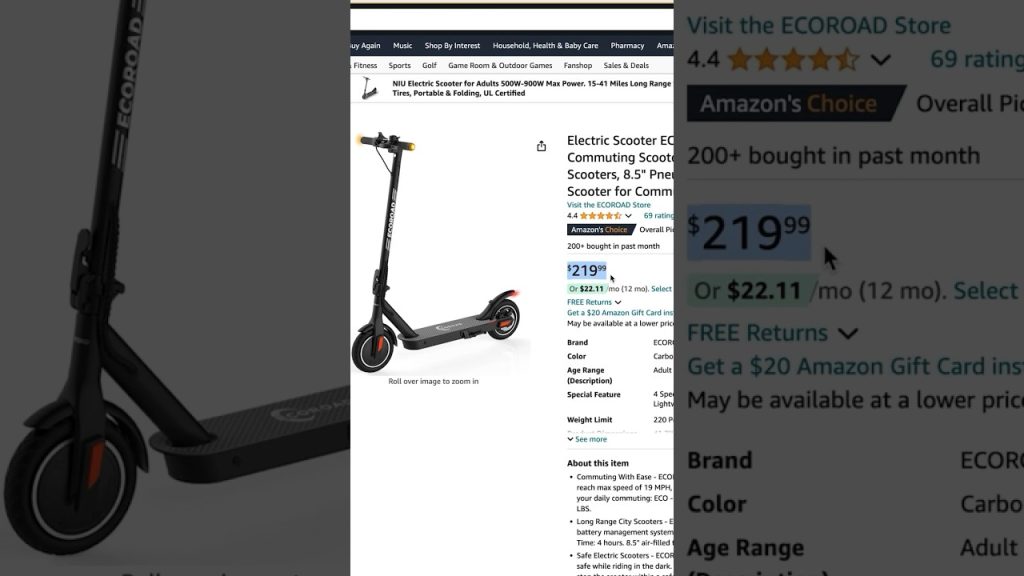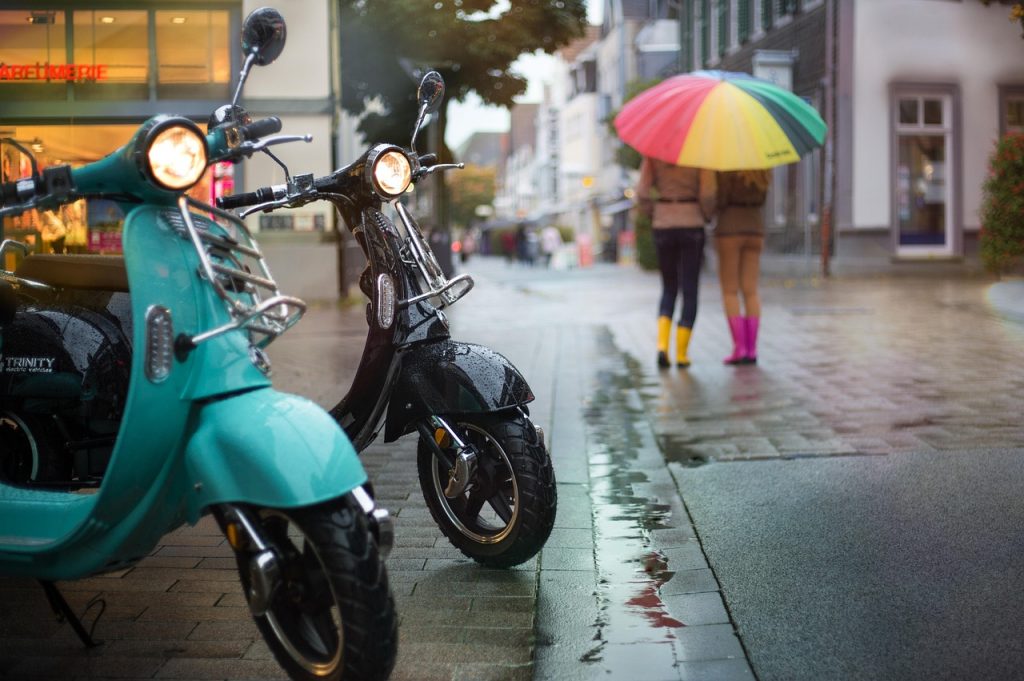You’ll get a straightforward breakdown of what a $200 scooter offers, covering motor power, battery life, build quality, and included accessories. The piece references a hands-on video by Electric Revolution and highlights real-world ride impressions alongside key specs.
You’ll learn whether that price delivers usable range, decent speed, and reliable components, plus tips on common compromises to watch for. This quick guide helps you decide if it’s a practical buy or if spending more yields significantly better value.

What a $200 scooter typically includes
Basic package contents such as scooter, charger, and user manual
When you buy a $200 scooter, you can typically expect the scooter itself, a basic charger, and a short user manual. The charger is often a small wall brick designed for the scooter’s battery voltage, and the manual covers assembly, safety basics, and warranty info — but don’t be surprised if tools and detailed instructions are minimal.
Common physical dimensions and weight expectations
You’ll usually see compact decks and relatively short stems on budget scooters. Expect a total length around 900–1100 mm (35–43 in) and a deck height that’s low to the ground. Total weight commonly falls between 10–18 kg (22–40 lbs), so most people can lift it short distances but may find it heavy for long carries.
Likely target use case: short commutes and recreational rides
A $200 scooter is aimed at short commutes, last-mile trips, and recreational rides on mostly flat, paved surfaces. You should view it as a neighborhood runabout or campus cruiser rather than a full-time commuter for long distances or hilly routes.
Typical manufacturer claims versus real-world performance
Manufacturers often advertise optimistic top speeds and ranges measured under ideal conditions. In real life, expect lower numbers once you factor in rider weight, stop-and-go traffic, temperature, and terrain. Think of advertised figures as best-case scenarios rather than guaranteed outcomes.
Commonly missing premium features found on higher-end models
At this price you won’t usually get features like regenerative braking, robust suspension, high-capacity batteries, powerful motors, app connectivity, high-end display panels, or IP-rated waterproofing. You should also expect simpler brakes, fewer lights, and less refined folding mechanisms.
Motor and propulsion
Typical motor power range and how it affects hill-climbing
Motors in this bracket commonly range from about 150W to 350W. That power is enough for flat terrain but marginal for steep hills; you’ll notice significant speed loss or inability to climb steep inclines, especially if you’re heavier or carrying cargo.
Hub motor versus external motor configurations
Most $200 scooters use hub motors integrated into the wheel, since hub motors are cheaper and simpler. External or mid-drive configurations are rare at this price. Hub motors keep the drivetrain simple but can limit cooling and torque compared with higher-end designs.
Expected motor efficiency and noise levels
Expect moderate efficiency — the motors will get you moving efficiently on flats but will struggle under heavy loads. Noise levels are generally low but you may hear whine or vibration under load; metallic or gear noise can be present on cheaper units.
How motor power translates to rider weight and speed
Motor power interacts directly with rider weight: heavier riders will see slower acceleration and lower top speeds. A 250W motor might hit 20–25 km/h (12–15 mph) with a light rider on flat ground, but the same motor will be noticeably slower with a heavier rider or uphill.
Common limitations like thermal protection and cutoffs
Budget scooters may have basic thermal protection or current cutoffs to prevent motor and controller damage, but these systems can be crude. You might experience sudden power reductions (thermal throttling) on long climbs or repeated hard acceleration.
Battery capacity and real-world range
Typical battery types and voltages found in this price bracket
You’ll commonly find small lithium-ion packs at 24V or 36V in entry-level models; very cheap or older units may use sealed lead-acid batteries but those are heavier and less common today. Capacities are modest — often in the 4–10 Ah range.
Manufacturer-claimed range versus realistic range factors
Manufacturers might claim ranges like 15–25 miles, but realistic range is often 40–70% of that claim depending on conditions. Claims are usually based on ideal rider weight, constant low speed, and flat terrain, so expect lower real-world numbers.
How rider weight, terrain and speed affect range
Higher rider weight, frequent stops and starts, higher cruising speeds, and hilly or rough terrain all reduce range. You’ll get the best range by riding at a steady, moderate speed on smooth, flat roads with minimal acceleration bursts.
Strategies to extend battery life and preserve range
You can extend range by keeping speeds moderate, avoiding aggressive starts, minimizing climbing routes, and maintaining proper tire pressure. Also, store the battery at moderate charge in cool, dry conditions and avoid full deep discharges when possible.
Battery lifespan, replacement cost and recyclability
A lithium battery pack in a budget scooter may last 300–600 charge cycles before capacity noticeably degrades. Replacement packs typically cost a significant fraction of the scooter’s price — often $50–$150 depending on chemistry and voltage. Lithium batteries are recyclable, but you should use proper collection points; don’t throw them in household trash.
Top speed and acceleration expectations
Typical top speed you can expect out of a $200 scooter
Typical top speeds are in the 12–20 km/h (7–12 mph) range for the lowest-end models, while better $200 offerings might reach 24–32 km/h (15–20 mph) under ideal conditions. Don’t expect anything close to performance scooter speeds.
Acceleration behavior from a standstill and at cruising speed
Acceleration tends to be gradual rather than punchy. From a standstill you’ll experience modest throttle response with some lag or stepped power delivery; at cruising speed the motor will maintain pace but won’t accelerate quickly if you ask for more.
How speed limits may be governed by firmware or motor limits
Manufacturers often limit speed with firmware, controller settings, or motor capability. Even if the motor could theoretically go faster, the controller and battery design often cap speed to protect components and meet safety or legal expectations.
Impact of weight and incline on top speed and acceleration
Rider weight and incline directly reduce both top speed and acceleration. On a climb, you may see your speed drop dramatically and acceleration become sluggish; some scooters may even approach complete cutoff if the motor overheats or the battery voltage sags.
Safety considerations when testing or exceeding rated speed
If you test speed, do so in a safe, open area with full protective gear. Exceeding rated speed risks instability, mechanical failure, and voiding warranty. The scooter’s braking and frame may not be engineered for speeds above ratings, increasing crash risk.

Build quality and materials
Common frame materials and their tradeoffs (steel vs alloy)
Budget scooters often use steel or low-cost aluminum alloys. Steel is strong and cheap but heavier and prone to rust; aluminum is lighter and corrosion-resistant but may be thin-gauged on budget models, affecting stiffness and durability.
Typical paint, finish and corrosion resistance quality
Expect basic paint or powder-coat finishes that look fine initially but may chip at edges or welds. Corrosion resistance is usually minimal; if you ride in wet or salty conditions, protective maintenance will be necessary to avoid rust and premature wear.
Weak points often seen at joints, folding mechanisms and mounts
Common failure points include the folding latch, headset, clamp bolts, and deck-to-stem joints. Cheap fasteners, inadequate weld quality, and insufficient reinforcement can lead to loosening or cracks over time — especially with heavier riders or rough use.
Expectation for durability under daily urban use
For light urban use — short, mostly smooth rides — a $200 scooter can last reasonably well with careful handling. Under heavy daily use, frequent potholes, or rough terrain, components may wear faster and require repairs or replacements.
How build quality affects long-term resale value
Build quality strongly influences resale value. A well-maintained scooter with solid materials and joints will fetch more than a flimsily constructed one. Given the low purchase price, depreciation is steep; expect modest resale returns even if you keep it in good condition.
Weight, portability and folding mechanism
Typical total weight and who can comfortably carry it
Typical weights range 10–18 kg (22–40 lbs). Most adults can carry that for short distances, but it’s not ideal for long carries or stair-heavy commutes. If you’re smaller or have mobility concerns, check weight carefully before buying.
How compact the scooter folds and measured folded dimensions
Budget scooters often fold to a compact profile by collapsing the stem against the deck, but folded length and height vary. Expect something that’s fit-for-car trunks and short transit stints but may still be awkward for tight storage spaces.
Quality and reliability of folding latches and hinges
Folding latches are often simple and can be a weak point. Some latches are plastic or thin metal and may loosen or wear. You should inspect locking points for play and test the mechanism several times to ensure a secure, rattle-free fold.
Practical portability for transit, stairs and storage
You can usually take a $200 scooter on public transit if weight and folded size meet rules, but carrying it up and down stairs frequently can be tiring. Check whether the scooter has a decent carrying position or balance when folded to make transit use practical.
Strap, handle or latch features that aid carrying
Some models include straps, small carry handles, or design elements that make one-handed carrying easier. Even a simple deck edge or stem-mounted latch can help; if you’ll carry the scooter often, choose a model with an intentional carrying feature.

Tires, suspension and ride comfort
Common tire types offered: solid, air-filled, or semi-solid
You’ll commonly find solid rubber or honeycomb tires on budget scooters, with a few models offering basic air-filled (pneumatic) tires. Semi-solid or foam-filled tires are less common but sometimes used to balance comfort and low maintenance.
How tire type affects ride comfort and puncture risk
Solid tires are low-maintenance and puncture-proof but transmit more vibration and feel rigid over bumps. Pneumatic tires offer better cushioning and traction but risk flats and need regular pressure checks. Foam fills are a middle ground with some shock absorption and no punctures.
Presence or absence of suspension and its effectiveness
Suspension is uncommon at this price point. If present, it’s typically a small spring or single dampener that provides limited improvement. Without effective suspension, you’ll feel more of the road, particularly on cracks, curbs, or rough pavement.
Typical handling characteristics on rough pavement
On rough surfaces, expect a jittery, less controlled ride on solid tires and low-grade suspension. Steering may feel twitchy at higher speeds, and you’ll likely slow down to maintain comfort and control.
Maintenance needs for tires and tips to improve comfort
For pneumatic tires, check pressure and patch flats promptly. For solid tires, inspect for excessive wear or cracking. To improve comfort, lower your speed, add ergonomic grips, or use thicker-sole shoes; some riders fit aftermarket tires or add simple aftermarket shock absorbers if the chassis allows.
Braking system and rider safety
Typical braking setups: electronic, drum, or mechanical disc
Budget scooters commonly use a combination of electronic regenerative or cut-off braking on the motor and a mechanical rear foot brake or drum brake. Mechanical disc brakes are uncommon but occasionally found; high-performance hydraulic systems are not expected at this price.
Braking responsiveness and stopping distance expectations
Braking responsiveness will be average to modest. Electronic braking provides initial deceleration but may be weak under heavy loads; mechanical brakes handle final stopping but can require longer distances than higher-end scooters. Expect stopping distances to be conservative — give yourself extra room.
Additional safety features like lights, reflectors and bell
You might get a basic front light, a rear reflector, and a small bell or horn. Headlights and brake lights are often low-lumen units; turn indicators are usually absent. You should not rely solely on built-in lighting for nighttime riding.
Recommended protective gear and legal helmet requirements
You should always wear a helmet and consider gloves, knee and elbow protection, and reflective clothing for visibility. Many jurisdictions legally require helmets for certain age groups; check your local laws and assume a helmet is mandatory for safety.
Common safety weaknesses and how to mitigate them
Weaknesses include poor lighting, marginal brakes, and flimsy structural components. Mitigate risks by performing pre-ride checks, upgrading lights and reflectors, reducing speed in poor conditions, and avoiding heavy loads or aggressive riding.

Lights, indicators and visibility
Typical front and rear lighting configurations and brightness
Expect a small LED headlight with modest output and a rear taillight or reflector. The headlight may be enough for low-speed visibility but often won’t fully illuminate dark roads. Brightness tends to be low compared with mid- or high-end scooters.
Presence or absence of turn indicators and brake lights
Turn indicators are rare at this price. Brake lights may be present as a simple rear LED that illuminates with electronic braking or as a passive reflector only. You should plan on manually signaling and using reflective clothing.
Reflectors and passive visibility aids included
Most scooters include basic reflectors on the rear, sides, or wheels. These help with visibility to other road users at night but are not a substitute for active lighting. Additional reflective tape or clothing is a cheap way to improve visibility.
Battery drain impact of lighting on overall range
Lights do draw some power, but their impact on range is generally small compared to motor use. Still, leaving lights on during long standby periods or using overly bright aftermarket lights can have a noticeable effect.
Aftermarket lighting and visibility upgrades to consider
You can significantly improve safety with aftermarket LED headlights, clip-on taillights, spoke lights, and reflective stickers. These are inexpensive upgrades that boost visibility without major changes to the scooter’s electrical system.
Conclusion
Summary of realistic expectations for a $200 scooter
A $200 scooter is a basic, entry-level vehicle suitable for short, flat, and casual trips. You should expect modest speed, limited range, basic components, and minimal extras. It’s a practical starter option if your needs are simple and budget-constrained.
Primary tradeoffs in performance, durability and features
The main tradeoffs are power and range versus cost: you get lower motor output, smaller batteries, simpler brakes, and lighter build quality in exchange for affordability. If you need higher performance, durability, or comfort, you’ll need to invest more.
Practical buying tips and checklist before purchase
Before you buy, check the scooter’s weight limit, motor power, battery voltage and capacity, actual folded dimensions, braking type, and warranty. Inspect the folding mechanism, test the throttle and brakes, and ask about replacement parts and battery availability.
Short-term value versus long-term ownership considerations
Short-term, a $200 scooter gives you immediate mobility at low cost. Long-term, consider battery degradation, potential repairs, and limited resale value. If you plan frequent or heavy use, a higher-quality model may be more cost-effective over time.
Recommended next steps: test ride, inspect specs and read reviews
Try to test ride the scooter in a safe area, inspect build and folding points for quality, and compare manufacturer specs to real-world reviews. Confirm warranty details and look for user feedback about battery life and common faults to make a confident purchase decision.



